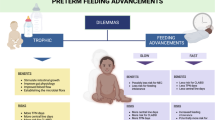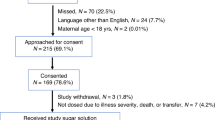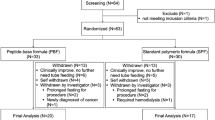Abstract
We conducted a controlled, randomized trial to study the effect of minimal enteral feeding on leucine uptake by splanchnic tissues, as an indicator of maturation of these tissues, in preterm infants in the first week of life. Within a few hours after birth, while receiving only glucose, a primed constant infusion of [1-13C]-leucine was started and continued for 5 h via the nasogastric tube, whereas 5,5,5 D3-leucine was infused intravenously (for both tracers, priming dose 2 mg/kg, continuous infusion 2 mg/kg/h). Patients were thereafter randomized to receive solely parenteral nutrition (C), parenteral nutrition and 20 mL breast milk/kg/d (BM), or parenteral nutrition and 20 mL formula/kg/d (F). On d 7, the measurements were repeated, after discontinuing the oral intake for 5 h. Fourteen infants were included in group C, 12 in group BM, and 12 in group F. There was no difference in energy intake or nitrogen balance at any time. On d 1, plasma enrichment for the nasogastric tracer was lower than for the intravenous tracer for all three groups, both for leucine and for α-keto-isocaproic acid. On d 7, the enrichment for leucine and α-keto-isocaproic acid for the nasogastric tracer was lower than for the intravenous tracer for the groups BM and F (BM: 3.65 ± 1.20 nasogastric versus 4.64 ± 0.64 i.v.; F: 4.37 ± 1.14 nasogastric versus 5.21 ± 0.9 i.v.). In the control group, there was no difference between tracers. The lower plasma enrichment for the nasogastric tracer compared with the intravenous tracer suggests uptake of leucine by the splanchnic tissues. We conclude that minimal enteral feeding—even in low volumes of 20 mL/kg/d—increases the leucine uptake by the splanchnic tissue. We speculate that this reflects a higher protein synthesis of splanchnic tissues in the groups receiving enteral nutrition.
Similar content being viewed by others
Log in or create a free account to read this content
Gain free access to this article, as well as selected content from this journal and more on nature.com
or
Abbreviations
- KIC:
-
α-keto-isocaproic acid
- VLBW:
-
very low birth weight
- QL:
-
Plasma leucine flux
- GI:
-
gastrointestinal
REFERENCES
Levine GM, Deren JJ, Steiger E, Zinno R 1974 Role of oral intake in maintenance of gut mass and disaccharide activity. Gastroenterology 67: 975–982.
Hughes CA, Dowling RH 1980 Speed of onset of adaptive mucosal hypoplasia and hypofunction in the intestine of parenterally fed rats. Clin Sci (Colch) 59: 317–327.
Chance WT, Foley Nelson T, Thomas I, Balasubramaniam A 1997 Prevention of parenteral nutrition-induced gut hypoplasia by coinfusion of glucagon-like-peptide-2. Am J Physiol 273:G559–G563.
Peterson CA, Carey HV, Hinton PL, Lo HC, Ney DM 1997 GH elevates serum IGF-1 levels but does not alter mucosal atrophy in parenterally fed rats. Am J Physiol 272:G1100–G1108.
Chance WT, Zhang X, Balasubramaniam A, Fisher JE 1996 Preservation of intestine protein by peptide YY during total parenteral nutrition. Life Sci 58: 1785–1794.
Berseth CL 1992 Effect of early feeding on maturation of the preterm infant's small intestine. J Pediatr 120: 947–953.
Berseth CL, Nordyke C 1993 Enteral nutrients promote postnatal maturation of intestinal motor activity in preterm infants. Am J Physiol 264:G1046–G1051.
Hoerr RA, Matthews DE, Bier DM, Young VB 1991 Leucine kinetics from [2H3]- and [13C]leucine infused simultaneously by gut and vein. Am J Physiol 260:E111–E117.
Beaufrère B, Fournier V, Salle B, Putet G 1992 Leucine kinetics in fed low birth weight infants: importance of splanchnic tissues. Am J Physiol 263:E214–E220.
Biolo G, Tessari P, Inchiostro S, Bruttomesso D, Fongher C, Sabadin L, Fratton MG, Valerio A, Tiengo A 1992 Leucine and phenylalanine kinetics during mixed meal ingestion: a multiple tracer approach. Am J Physiol 262:E455–E462.
Matthews DE, Marano MA, Campbell RG 1993 Splanchnic bed utilization of leucine and phenylalanine in humans. Am J Physiol 264:E109–E118.
Biolo G, Tessari P 1997 Splanchnic versus whole-body production of α-ketoisocaproate from leucine in the fed state. Metabolism 46: 164–167.
Cortiella J, Matthews DE, Hoerr RA, Bier DM, Young VR 1988 Leucine kinetics at graded intakes in young men: quantitative fate of dietary leucine. Am J Clin Nutr 48: 998–1009.
Cayol M, Boirie Y, Rambourdin F, Prugnaud J, Gachon P, Beaufrére B, Obled CH 1997 Influence of protein intake on whole body and splanchnic leucine kinetics in humans. Am J Physiol 272:E584–E591.
Boirie Y, Gachon P, Beaufrére B 1997 Splanchnic and whole-body kinetics in young and elderly men. Am J Clin Nutr 65: 489–495.
Ballard JL, Khoury JC, Wedig K, Wang L, Eilers-Walsman BL, Lipp R 1991 New Ballard score, expanded to include extremely premature infants. J Pediatr 119: 417–423.
Usher RH, McLean F 1969 Intrauterine growth of live born Caucasian infants at sea level: standards obtained from measurements in 7 dimensions of infants born between 25 and 44 weeks of gestation. J Pediatr 74: 901–910.
The International Neonatal Network 1993 The CRIB (clinical risk index for babies) score: a tool for assessing initial neonatal risk and comparing performance of neonatal intensive care units. Lancet 342: 193–198.
VanGoudoever JB, Sulkers EJ, Halliday D, Degenhart HJ, Carnielli VP, Wattimena JLD, Sauer PJ 1995 Whole body protein turnover in preterm AGA and SGA infants: comparison of [15N]glucine and [1-13C]leucine administered simultaneously. Ped Res 37: 381–388.
Schwenk WF, Beaufrère B, Haymond MW 1985 Use of reciprocal pool specific activities to model leucine metabolism in humans. Am J Physiol 246:E646–E650.
Buddington RK 1994 Nutrition and ontogenic development of the intestine. Can J Physiol Pharmacol 72: 251–259.
Kien CL, Horswill CA, Zipf WB, McCoy KS, Denne SC 1999 Splanchnic uptake of leucine in healthy children and in children with cystic fibrosis. Pediatr Res 45: 680–683.
Matthews DE, Schwarz HP, Yang RD, Motil KJ, Young VR, Bier DM 1982 Relationship of plasma leucine and α-ketoisocaproate during a L-[1-13C]leucine infusion in man: a method for measuring human intracellular leucine tracer enrichment. Metabolism 31: 1105–1112.
Matthews DE, Harkin R, Battezzati A, Brillon DJ 1999 Splanchnic bed utilization of enteral alpha-ketoisocaproate in humans. Metabolism 48: 1555–1563.
Van Goudoever JB, Colen T, Wattimena JL, Huijmans JG, Carnielli VP, Sauer PJ 1995 Immediate commencement of amino acid supplementation in preterm infants: effect on serum amino acid concentrations and protein kinetics on the first day of life. J Pediatr 127: 458–465.
Rivera A, Bell EF, Bier DM 1993 Effect of intravenous amino acids on protein metabolism of preterm infants during the first three days of life. Pediatr Res 33: 106–111.
Mitton SG, Garlick PJ 1992 Changes in protein turnover after the introduction of parenteral nutrition in premature infants: comparison of breast milk and egg protein-based amino acid solutions. Pediatr Res 32: 447–454.
Acknowledgements
The authors thank Sagrario Lara, Rosa Codoceo, and Villar Palasí for excellent technical assistance, and the staff of the Neonatal Intensive Care Unit at La Paz University Hospital for their help in carrying out these studies.
Author information
Authors and Affiliations
Corresponding author
Additional information
Supported by grants BAE 96/5234, BAE 97/5188, FIS 98/1101 from the Spanish National Institute of Health.
Rights and permissions
About this article
Cite this article
De Pipaón, M., Vanbeek, R., Quero, J. et al. Effect of Minimal Enteral Feeding on Splanchnic Uptake of Leucine in the Postabsorptive State in Preterm Infants. Pediatr Res 53, 281–287 (2003). https://doi.org/10.1203/01.PDR.0000047519.22873.3F
Received:
Accepted:
Issue date:
DOI: https://doi.org/10.1203/01.PDR.0000047519.22873.3F



